engine BUICK PARK AVENUE 1998 Owners Manual
[x] Cancel search | Manufacturer: BUICK, Model Year: 1998, Model line: PARK AVENUE, Model: BUICK PARK AVENUE 1998Pages: 426, PDF Size: 23.59 MB
Page 81 of 426

It can be dangerous to drive with the trunk lid
open because carbon monoxide (CO) gas can
come into your vehicle. YOU can’t see or smell1
CO. It can cause unconsciousness and even death.
If you must drive with the trunk lid open OF if
electrical wiring or other cable connections must
pass through the seal between the body and the
trunk lid:
0 Make sure all windows are shut.
Turn the
fan on your heating OF cding
system to its highest speed with the setting
on any airflow selection except RECHWC.
That will force outside air inkt your vehicle.
See
“Comfort Controls” in the Index.
If you have air outiets on or under the
instrument panel, open them all the way.
See “Engine Exhaust’’ in the Index.
.-p->:. . I. !< :. I 1.: ::::, .,,::.-<:. -- :,
Vehicie theft is big business, especiafly in some cities.
Although yaur vehicle has a number of theft-deterrent
features. we
know that nothing we put on kt can make it,
impossible to steal. However, there are wzys you
can help.
.... -
.LL;; , .:.L <,.c;;.;; &iLL&:.< ..I.:- :i4,’ .T”T$,T .:,..-. .?L. >- P .” ..<. :<.:,-.-.
If you leave YQUF vehicle with the keys inside, it’s m
easy target for joy riders or professional thieves -- so
don’t do it.
With the ignition off and the driver’s door open, YQU’IB
hear a chime reminding you to remove your key from
the ignition
md take it with you. Always do tk. Your
ignition and trmsaxie will be Hocked. And remember to
lock the doors.
:;c. 15 ;:,- < FA:. c: Fi, ;- 3;:: c,; ::-$ .:;-
Pa-k in a lighted spot, close all windows and lock your
vehicle. Remember to keep your valuables out of sight.
Put them in a storage area, or take them with you.
. .. . -~ -.&ZL
“7.:. - , ..._ 2 GA &nr2., _v : --;<. ..Ab v 3 .-
ProCarManuals.com
Page 84 of 426
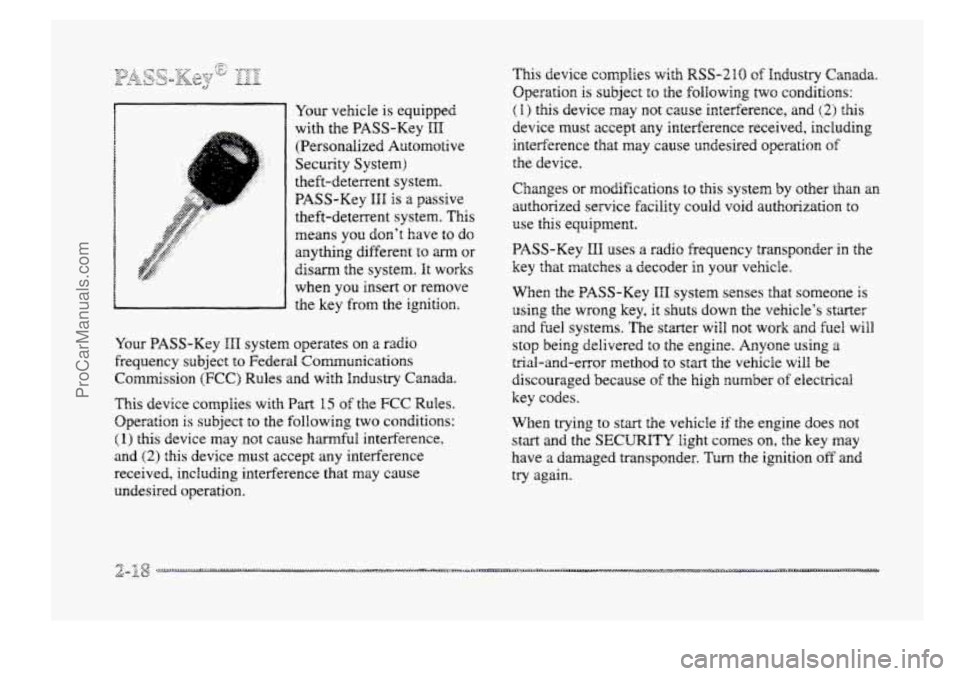
Your vehicle is equipped
with the PASS-Key
III
(Persondized Automotive
Security System)
theft-deterrent system.
PASS-Key
HHI is a passive
theft-deterrent system.
This
means you don’t have to do
anything different to arm or
disarm the system. It works
when YOU insert or remove
the key
from the ignition.
Your PASS-Key
III system operates on a radio
frequency
subject to Federal Communications
Commission
(FCC) Rules and with Industry Canada.
This device complies
with Part 15 of the FCC Rules.
Operation
is subject to the following two conditions:
(I) this device may not cause harmful interference,
and
(2) this device must accept any interference
received, including interference that may cause
undesired operation.
This device complies with RSS-210 of Industry Canada.
Operation
is subject to the following two conditions:
(I) this device may not cause interference, and (2) this
device must accept any interference received, including
interference that may cause undesired operation
of
the device.
Changes
or modifications to this system by other than an
authorized service facility could void authorization to
use this equipment.
PASS-Key
HI1 uses a radio frequency transponder in the
key that matches a decoder in your vehicle.
When the PASS-Key
III system senses that someone is
using the wrong key, it shuts
down the vehicle’s starter
and fuel systems.
The starter will not work and he8 will
stop being delivered to the engine. Anyone using a
trial-and-error method to start the vehicle will be
discouraged because
of the high number of electrical
key codes.
When trying
to start the vehicle if the engine does not
start and the SECURITY light comes on, the key may
have
a damaged transponder. Turn the ignition off and
try again.
ProCarManuals.com
Page 85 of 426
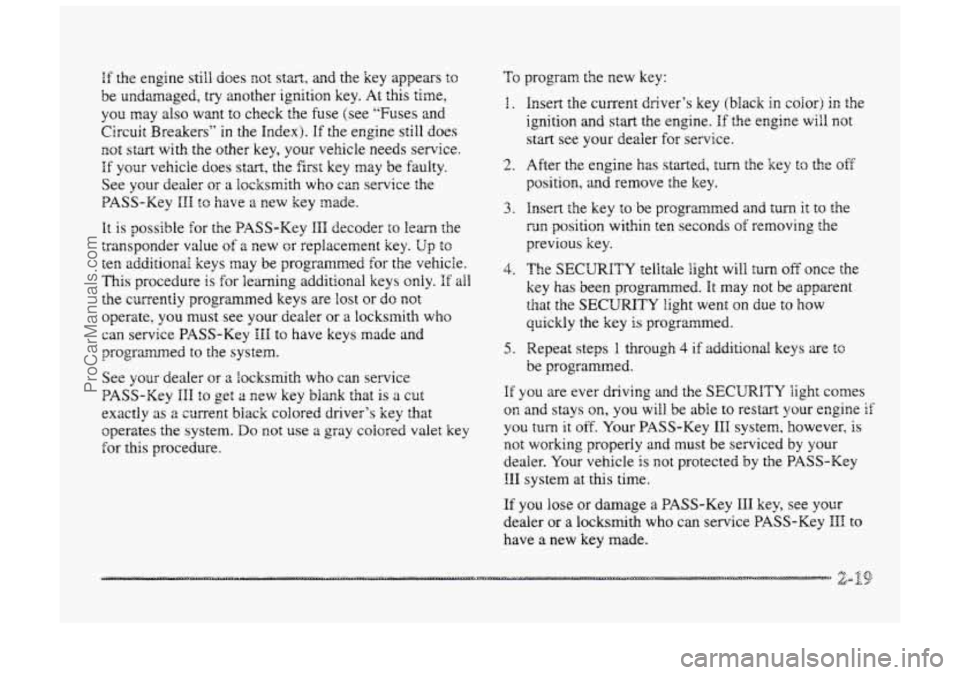
If the engine still does not start, and the key appears to
be undamaged, try mother ignition key. At this time,
you may also want to check the fuse (see “Fuses and
Circuit Breakers’‘
in the Index). If the engine still does
not start with the other key, your vehicle needs service.
If your vehicle does start, the €kt key may be faulty.
See your dealer or a
Iocksrnith who can service the
PASS-Key
IIH tc have a new key Bade.
It is possible for the PASS-Key IIP decoder to learn the
transponder value
of a new replacement key. Up to
ten additional keys may be programmed for the vehicle.
This procedure is €or learning additional keys only. If all
the currently programed keys are lost or do not
operate, you must see your dealer or a locksmith who
can service PASS-Key
HI1 to have keys made and
programmed
to the system.
See your dealer or 2 locksmith who can service
PASS-Key
III to get 2 new key blank that is a cut
exactly
as a current black colored driver’s key that
operztes the system.
Do not use 2 gray colored valet key
for this procedure.
To program the new key:
1.
2.
3.
4.
5.
Insert the cumrent driver’s key (black in color) i~* the
ignition
and start the engine. If the engine wiil not
start see your dealer for service.
After the engine has started,
turn the key to the off
position, and remove the key.
Insert the key
to be progrmmed and turn it to the
mn position within ten seconds of removing the
previous key.
The
SECURITY telltale iight will off once the
key
has been programmed. It may not be apparent
that the SECURITY light went on due to how
quickly
the key is programmed.
Repeat steps
1 through 4 if additional keys are to
be programmed.
ff you are ever driving and the SECURITY iight comes
or; and stays on, you will be able to restart your engine if
you turn it off. Your BASS-Key III system, however, is
not working properly and must be serviced by your
dealer.
You vehicle is not protected by the PASS-Key
III system at this time.
If you lose or damage a PASS-Key I11 key, see your
dealer or a locksmith who can service PASS-Key HIT to
have a new key made.
ProCarManuals.com
Page 87 of 426
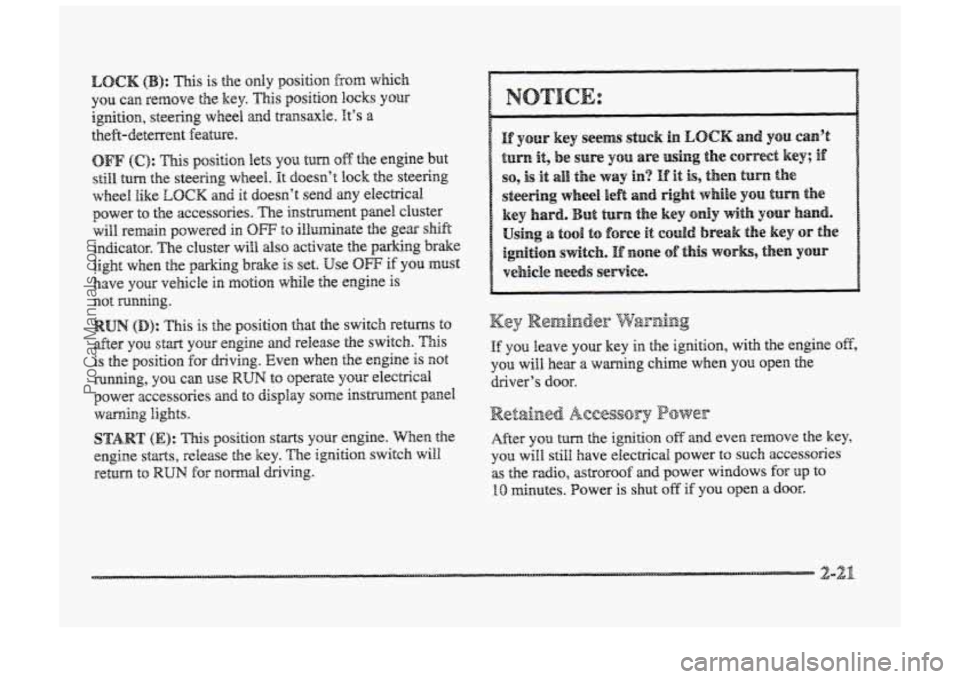
I
LOCK @I: This is the only position from which
YOU can remove the key. This position locks YOU
igition, steering wheel and transaxle. It’s a
theft-deterrent feature.
OFF (C): This position lets YOU turn ofif the engine but
still turn the steering wheel. It doesn’t lock the steering
wrlhee1 like LOCK and it doesn’t send my electrical
power to
the accessories. The instrument panel cluster
will remain powered in OFF to illarminate the gear sWt
indicator. The cluster will also activate the parking brake
fight when the parking brake is set. Use OW if you must
have your vehicle in motion while the engine is
not mnanaing.
RUN (D): This is the position that the switch returns to
after you start YSUP engine and release the switch. This
is &e p~sisi~n for driving. Even when the engine is not
running, you can use RUN to operate your electrical
power accessories anad t~ display some instrument panel
START (E): This position starts your engine. When the
engine
starts, release the key. The ignition switch will
return to RUN for ~a~rrrnal driving.
wdng
lights.
Retained Acces§ory Power
After you turn the ignition off md even remove the key,
you
will still have electrical power to such accessories
as the radio, astroroof ad power windows for up to
10 minutes. Power is shut off if you open a door.
2-21
ProCarManuals.com
Page 88 of 426

Move your shift lever to BARK (B) or NEUTRAL (N).
Your engine won’t start in any other position -- that’s a
safety feature. To restart when you’re already moving,
use NEUTRAL (N) only.
1 NOTICE:
Don9t try to shift to PARK (a) if your hick is
moving. If YOU do, YOU could damage the
transaxle.
Shift to PARK (P) only when your
vehicfe is stopped.
8. Without pushing the accelerator pedal, turn your
ignition key to START. When the engine starts, let
go
of the key. The idle speed will go down as your
engine gets wann.
NOTICE:
Holding your key in START €or longer than
15 seconds at a time will cause your battery to be
drained much sooner.
And the excessive heat can
damage your starter motor.
2. if it doesn’t start right away, hold your key in
START for about three to five seconds at a time until
your engine starts. Wait about 15 seconds between
each
try to help avoid draining your battery or
damaging your starter.
3. If your engine still won’t start (or starts but then
stops), it could be flooded with too much gasoline.
Try pushing your accelerator pedal
all the way to the
floor
and holding it there as you hold the key in
START for about three seconds. If the vehicle starts
briefly but then stops again, do the same thing, but
this time keep the pedal down for five or
six seconds.
This clears the extra gasoline from the engine.
After waiting
about 15 seconds, repeat the normal
starting procedure.
ProCarManuals.com
Page 89 of 426
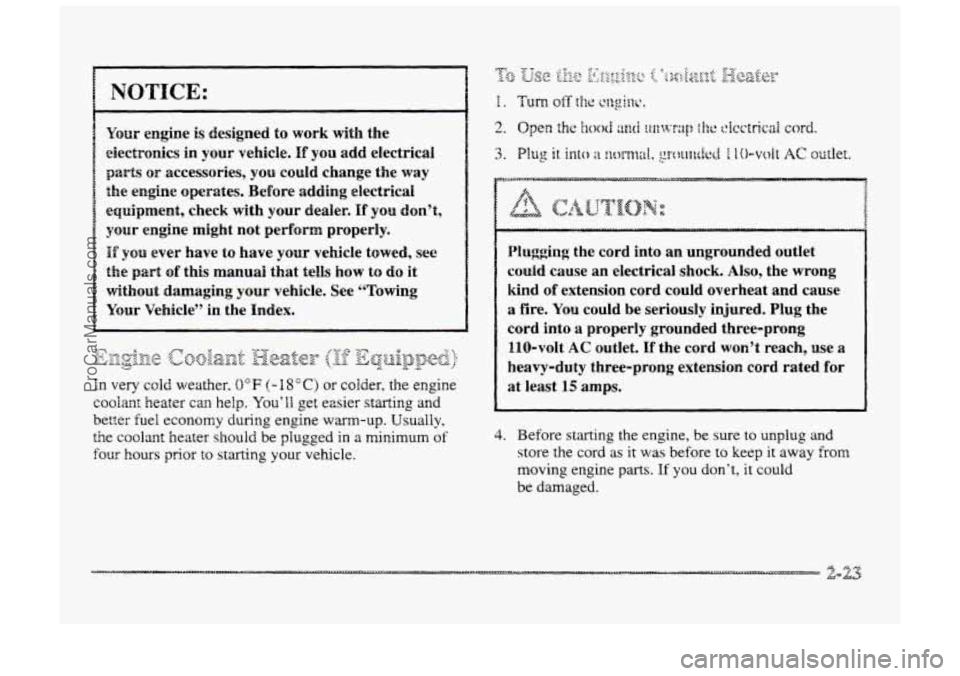
NOTICE:
Your engine is designed to work with the
electronics
in your vehicle. If you add electrical
parts OF accessories, you could change the way
the engine operates. Before adding electrical
equipment, check with your dealer.
If you don’t,
your engine might not perform properly.
If yon ever have to have your vehicle towed, see
the past of this manual that tells how to do it
without damaging your vehicle. See “Towing
Your Vehicle” in the Index.
In very cold weather, 0 OF (- I 8 O C) or colder, the engine
coolant
heater can he8p. You’ll get easier starting and
better fuel economy during engine wm-up. Usually,
the coolant heater should be plugged in a minimum of
four hours prior to starting your vehicle.
I_ -I
cigUTE[y%q @ -. .. b.8
Plugging t.he cord into an ungrounded outlet
could cause an electrical shock. Also, the wrong
kind of extension cord could overheat and cause
a fire. You could be seriously injured. Plug the
cord into
a properly grounded three-prong
110-volt
AC outlet. If the cord won’t reach, use a
heavy-duty three-prong extension cord rated for
at least
15 amps.
4. Before starting the engine, be sure to unplug and
store the cord as it was before to keep it away from
moving engine parts. If you don’t, it could
be damaged.
ProCarManuals.com
Page 90 of 426
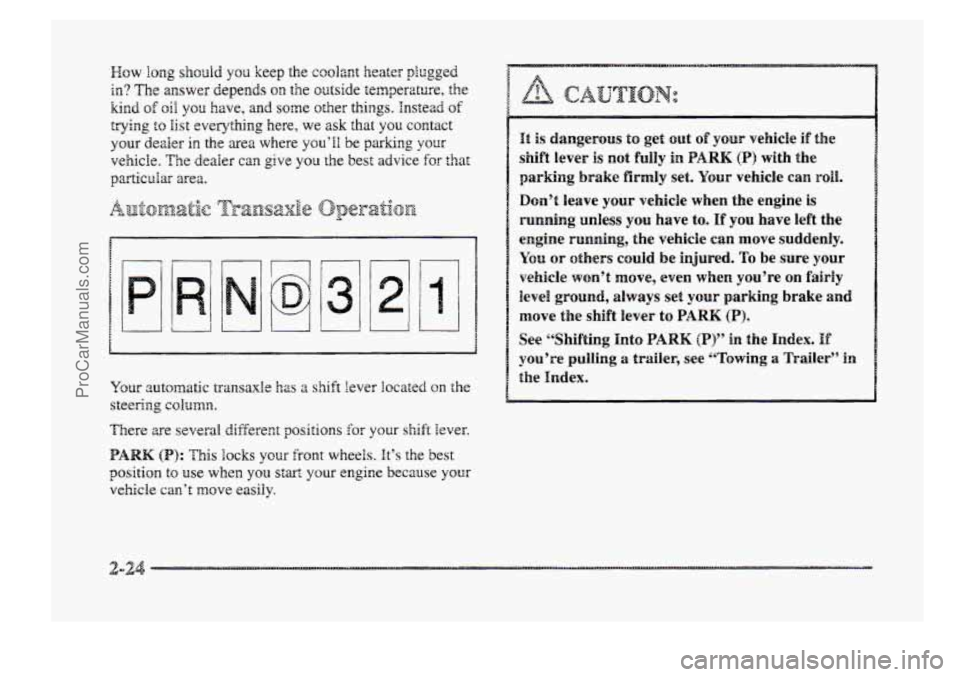
Wow long shodd YOU keep the coolant heater plugged
in? The answer depends on the outside temperature, the
kind of oil you have, and some other things. Instead of
trying t~ list everything here, we ask that you contact
your
dealer in the area where you’ll be parking pur
vehicle. The dealer cm give you the best advice for that
particdar area.
Y0mr automatic transaxle has a shift lever located on the
steering column.
There we several different positions for your shift lever.
PARK (PI: This Bocks your front wheels. It’s the best
position t~ we when YOU start your engine because pl~r
vehicle can’t move easily.
CAUTION:
I& is dangerous to get out of your vehick if the
shift lever is not fully in PARK (P) with the
parking brake firmly set.
Your vehicle can roll.
Don’t leave your vehicle when the engine is
running unless you have to. If you have left the
engine running, the vehicle can move suddenly.
You or others could be injured. TQ be sure your
vehicle won’t move, even when you’re on fairly
level ground, always set
y0w parking brake and
move the shift lever to PARK (P).
See ‘“Shifting Hnt~ PARK (P)” in the Index. If
you’re pulling a trailer, see “Towing a Trailer” in
the Index.
2-24
ProCarManuals.com
Page 91 of 426
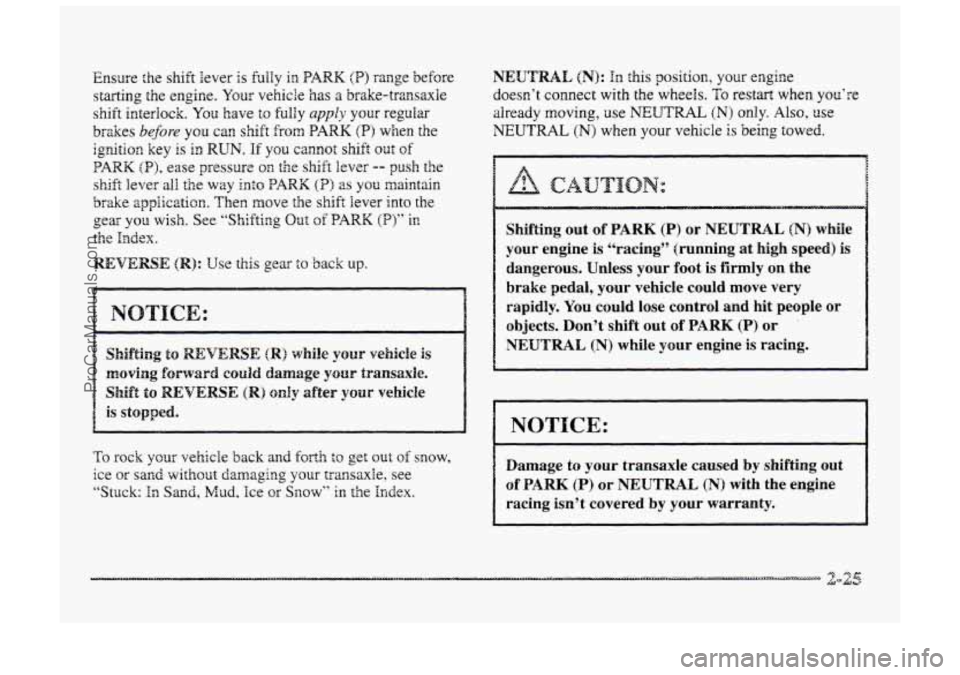
Ensure the shift lever is fuily in PARK (PI range before
starting the engine.
Your vehicle has a brake-transaxle
shift interlock.
You have to fully apply your regular
brzkes
before you can shift from PARK (P) when the
ignition key is in RUN. If you cannot shift out of
PARK (B), ease pressure on the shift lever -- push the
shift lever all the way into PARK (P) as you rnaintain
brake appiic~tion. Then move the shift lever into the
gear you wish. See “Shifting Out of PARK (E’)” in
the Index.
REVERSE (R): Use this gear to back up.
Shift to REVERSE (R) oanhy after vehicle
To rock your vehicle back and forth to get out of snow,
ice sand without damaging your transaxle, see
“Stuck:
In Sand, Mud, Ice or Snow” in the Index.
NEUTRAL (N): In this position, your engim
doesn’t connect with the wheels.
To restart when you’re
already
moving, use NEUTRAL (N) only. Also, use
NEUTRAL (N) when your vehicle is being towed.
Shifting out of PARK (P) or NEUTRAL fN) while
your engine is “racing” (running
at high speed) is
dangerous. Unless your foot is firmly on the
brake pedal, your vehicle could move very
rapidly. You could lose control and hit people
or
objects. Don’t shift out of PARK (P) or
NEUTRAL (N) while your engine is racing.
1 NOTICE:
Damage to your transaxle caused by shifting out
of PARK (P) or NEUTRAL (N) with the engine
racing isn’t covered by your warranty.
ProCarManuals.com
Page 92 of 426
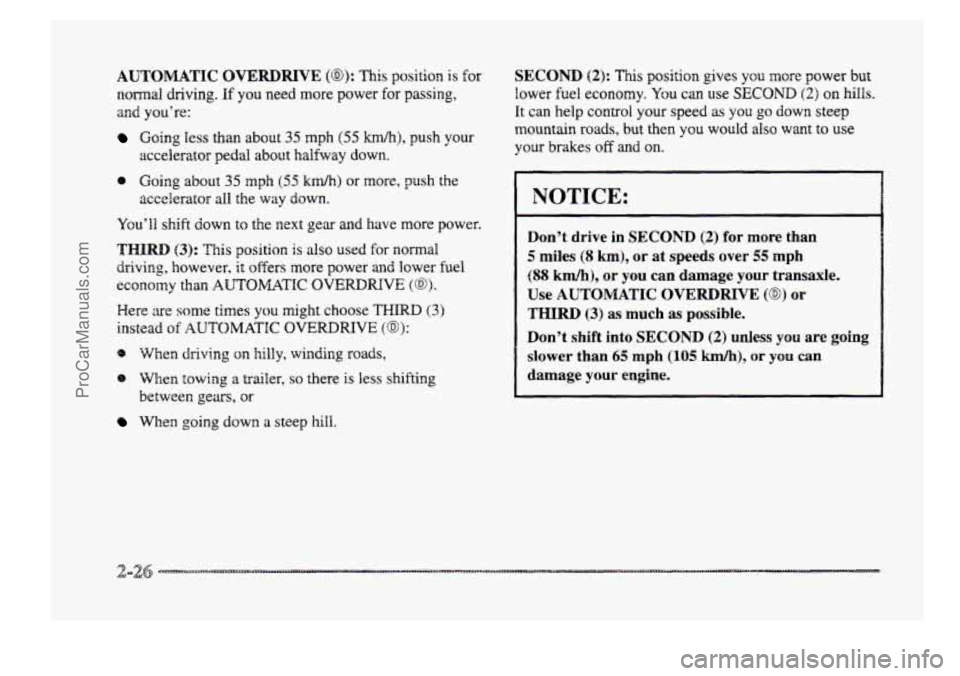
AUTOMATIC OVERDRIVE (@):This positionis for
normal driving. Pf you need more power for passing,
and you’re:
Going less than about 35 mph (55 kmh), push your
accelerator pedal about halfway down.
e Going about 35 mph (55 kmh) or more, push the
accelerator
all the way down.
You’U shift down to the next gear and have more power.
THIRD (3): This position is also used for normal
driving, however, it offers more power and Bower fuel
economy than AUTOMATIC OVERDRIVE (0).
Here are some times you might choose THIRD (3)
instead of AUTOMATIC OVERDRIVE (a):
Qb When towing a trailer, so there is less shifting
between gears,
or
SECQND (2): This position gives you nore power but
lower fuel economy. YQU can use SECOND (2) on hills.
It can help control your speed as you go down steep
mountain roads, but
then you would also want to use
your
brakes off and on.
NOTICE:
Don’t drive in SECOND (2) for more than
5 miles (8 km), or at speeds over 55 mph
(88 km/h), or you can damage your transaxle.
Use AUTOMATIC OVERDRIVE (0) or
THIRD (3) as much as possible.
Don’t shift into SECOND
(2) unless you are going
slower than
65 mph (105 km/h), or you can
damage your engine.
When going down a steep hill.
ProCarManuals.com
Page 94 of 426
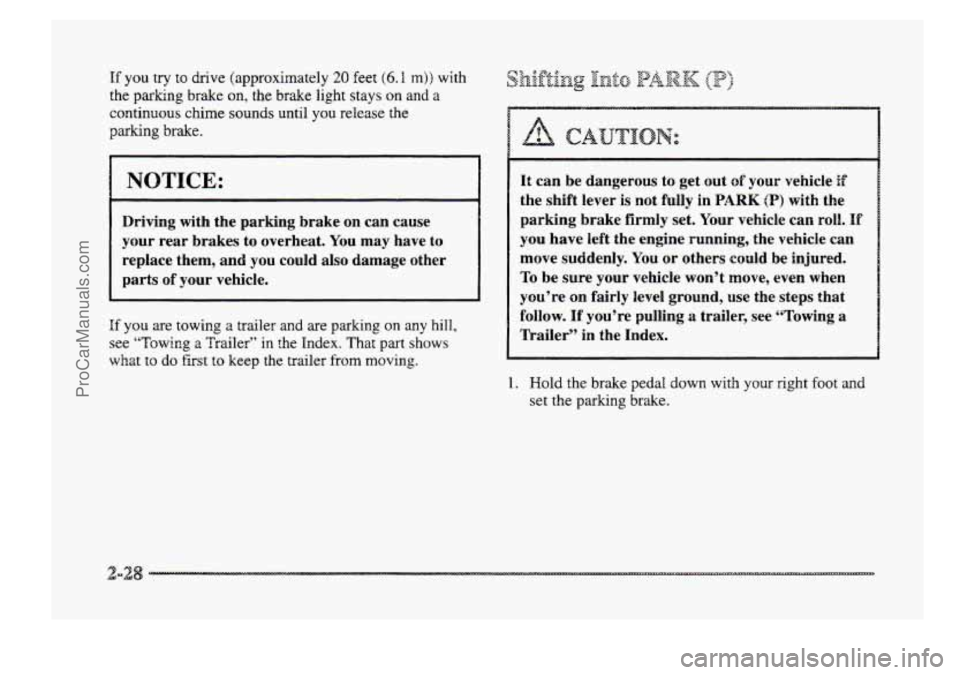
If you try to drive (approximately 20 feet (6.9 m)) with
the
parlkrng brake on, the brake light stays on and a
continuous chime sounds until you release the
parking
brake.
NOTICE:
Driving with the parking brake on can cause
your rear brakes to overheat. You may have to
replace them, and you could also damage other
parts
of your vehicle.
If you are towing a trailer and are parking on any hill,
see “Towing a Trailer” in the Index. That part shows
what
to do first to keep the trailer from moving.
It can be dangerous to get out of your vehicle if
the shift lever is not fully in PARK (P) with the
parking brake firmly set. Your vehicle can roll.
If
you have left the engine running, the vehicle can
move suddenly. You or others
could be injured.
To be sure your vehicle won’t move, even when
you’re on fairly level ground,
use the steps that
follow.
If you’re pulling a trailer, see “Towing a
Trailer” in the Index.
1. Hold the brake pedal down with your right foot and
set the parking brake.
ProCarManuals.com